An Artificial Magnetic Conductor-Backed Compact Wearable Antenna for Smart Watch IoT Applications
Abstract
:1. Introduction
2. Design Analysis of the Proposed Antenna
2.1. Design Steps of the Proposed Antenna
2.2. Equivalent Circuit Model
2.3. Parametric Study of the Designed Antenna
2.4. Bending Analysis of the Proposed Antenna
2.4.1. Bending Analysis along the x-Axis
2.4.2. Bending Analysis along the y-Axis
2.5. Radiation Pattern of Proposed Antenna
2.6. Surface Current Density of the Proposed Antenna
3. Design of an AMC Unit Cell
3.1. Surface Current Distribution
3.2. Parametric Analysis of the AMC Unit Cell
3.3. Design of an AMC-Backed Antenna
3.4. Bending Analysis of the AMC-Backed Antenna
3.4.1. Bending Analysis along the x-Axis
3.4.2. Bending Analysis along y-Axis
4. Specific Absorption Rate (SAR) Analysis
5. Fabrication and Measurements
5.1. Fabrication and Measurements of the Proposed Antenna
5.2. Fabrication and Measurements of the AMC-Backed Antenna in Free Space
5.3. Fabrication and Measurements of the AMC-Backed Antenna on a Smart Hand Watch
6. Conclusions
Author Contributions
Funding
Conflicts of Interest
References
- Kumar, S.A.; Shanmuganantham, T. Design of CPW-Fed Inverted Si× Shaped Antenna for IoT Applications. Trans. Electr. Electron. Mater. 2020, 21, 524–527. [Google Scholar] [CrossRef]
- Al-Sehemi, A.; Al-Ghamdi, A.; Dishovsky, N.; Atanasova, G.; Atanasov, N. A flexible broadband antenna for IoT applications. Int. J. Microw. Wirel. Technol. 2020, 12, 531–540. [Google Scholar] [CrossRef]
- Jia, Y.; Liu, L.; Hu, J.; Xu, L.-J. Miniaturized wearable watch antenna for wristband applications. In Proceedings of the 2019 IEEE MTT-S International Microwave Biomedical Conference (IMBioC), Nanjing, China, 6–8 May 2019. [Google Scholar]
- Wen, D.; Hao, Y.; Wang, H.; Zhou, H. A wearable antenna design using a high impedance surface for all-metal smartwatch applications. In Proceedings of the 2017 International Workshop on Antenna Technology: Small Antennas, Innovative Structures, and Applications (iWAT), Athens, Greece, 1–3 March 2017. [Google Scholar]
- Ghaffar, A.; Awan, W.A.; Hussain, N.; Ahmad, S.; Li, A.X.J. A compact dual-band flexible antenna for applications at 900 and 2450 MHZ. Prog. Electromagn. Res. Lett. 2021, 99, 83–91. [Google Scholar] [CrossRef]
- Fan, M.; Wen, C.; Tang, J. Design of a Smartwatch for IoT Application under 5G Environment. In Proceedings of the 2020 IEEE 4th Information Technology, Networking, Electronic and Automation Control Conference (ITNEC), Chongqing, China, 12–14 June 2020. [Google Scholar] [CrossRef]
- De Cos Gómez, M.E.; Álvarez, H.F.; González, C.G.; Valcarce, B.P.; Olenick, J.; Las-Heras, F. Ultra-Thin Compact Flexible Antenna for IoT Applications. In Proceedings of the 2019 13th European Conference on Antennas and Propagation (EuCAP), Krakow, Poland, 31 March–5 April 2019. [Google Scholar]
- Zhao, K.; Ying, Z.; He, S. Antenna designs of smart watch for cellular communications by using metal belt. In Proceedings of the 9th European Conference on Antennas and Propagation (EuCAP), Lisbon, Portugal, 13–17 April 2015. [Google Scholar]
- Wu, D.; Cheung, S.W.; Li, Q.L.; Yuk, T.I. Slot antenna for all-metal smartwatch applications. In Proceedings of the 2016 10th European Conference on Antennas and Propagation (EuCAP), Davos, Switzerland, 10–15 April 2016. [Google Scholar]
- Chung, M.; Yang, C. Built-in antenna design for 2.4 GHz ISM band and GPS operations in a wrist-worn wireless communication device. IET Microw. Antennas Propag. 2016, 10, 1285–1291. [Google Scholar] [CrossRef]
- Hasan, M.; Faruque, M.R.I.; Islam, M.T. Dual Band Metamaterial Antenna For LTE/Bluetooth/WiMAX System. Sci. Rep. 2018, 8, 1–17. [Google Scholar] [CrossRef] [PubMed] [Green Version]
- Hasan, M.; Rahman, M.; Faruque, M.R.I.; Islam, M.T.; Khandaker, M.U. Electrically Compact SRR-Loaded Metamaterial Inspired Quad Band Antenna for Bluetooth/WiFi/WLAN/WiMAX System. Electronics 2019, 8, 790. [Google Scholar] [CrossRef] [Green Version]
- Cheung, C.Y.; Yuen, J.S.M.; Mung, S.W.Y. Miniaturized Printed Inverted-F Antenna for Internet of Things: A Design on PCB with a Meandering Line and Shorting Strip. Int. J. Antennas Propag. 2018, 2018, 1–5. [Google Scholar] [CrossRef] [Green Version]
- Fady, B.; Tribak, A.; Terhzaz, J.; Riouch, F. Novel Low-Cost Integrated Multiband Antenna Design Customized for Smartwatch Applications with SAR Evaluation. Int. J. Antennas Propag. 2020, 2020, 1–14. [Google Scholar] [CrossRef]
- Khalilabadi, A.J.; Zadehgol, A. An Ultra-thin Triple-band Smartwatch Antenna with Support of Several Wireless Application Bands. In Proceedings of the 2019 IEEE International Symposium on Antennas and Propagation and USNC-URSI Radio Science Meeting, Atlanta, GA, USA, 7–12 July 2019; pp. 1281–1282. [Google Scholar]
- Cheng, C.-M.; Chen, W.-S.; Lin, G.-Q.; Chen, H.-M. Four antennas on smart watch for GPS/UMTS/WLAN MIMO application. In Proceedings of the 2017 IEEE International Conference on Computational Electromagnetics (ICCEM), Kumamoto Japan, 8–10 March 2017; pp. 346–348. [Google Scholar]
- Jin, Y.N.; Choi, J. Bandwidth enhanced compact dual-band smart watch antenna For WLAN 2.4/5.2GHz application. In Proceedings of the 2017 International Applied Computational Electromagnetics Society Symposium (ACES), Firenze, Italy, 26–30 March 2017. [Google Scholar]
- Huang, H.-S.; Su, H.-L.; Chen, S.-L. Multiband antennas for GPS/GSM1800/Wi-Fi smart watch applications. In Proceedings of the 2017 IEEE International Conference on Computational Electromagnetics (ICCEM), Kumamoto Japan, 8–10 March 2017; pp. 352–354. [Google Scholar]
- Chiu, C.-Y.; Shen, S.; Murch, R.D. Transparent dual-band antenna for smart watch applications. In Proceedings of the 2017 IEEE International Symposium on Antennas and Propagation & USNC/URSI National Radio Science Meeting, San Diego, CA, USA, 9–14 July 2017; pp. 191–192. [Google Scholar]
- Zou, H.; Li, Y.; Peng, M.; Wang, M.; Yang, G. Triple-Band Loop Antenna for 5G/WLAN Unbroken-Metal-Rimmed Smartwatch. In Proceedings of the 2018 IEEE International Symposium on Antennas and Propagation & USNC/URSI National Radio Science Meeting, Boston, MA, USA, 8–13 July 2018; pp. 463–464. [Google Scholar]
- Wu, D.; Cheung, S.W. A Cavity-Backed Annular Slot Antenna with High Efficiency for Smartwatches with Metallic Housing. IEEE Trans. Antennas Propag. 2017, 65, 3756–3761. [Google Scholar] [CrossRef]
- Su, S.-W.; Hsieh, Y.-T. Integrated metal-frame antenna for smart watch wearable device. IEEE Trans. Antennas Propag. 2015, 63, 3301–3305. [Google Scholar] [CrossRef]
- Lee, W.-Z.; Chen, W.-S. An antenna design on metal frame of smart watch. In Proceedings of the 2019 International Workshop on Electromagnetics: Applications and Student Innovation Competition (iWEM), Penghu, Taiwan, 26–28 August 2020. [Google Scholar]
- Wang, B.; Yan, S. Design of Smartwatch Integrated Antenna With Polarization Diversity. IEEE Access 2020, 8, 123440–123448. [Google Scholar] [CrossRef]
- Lu, J.-H.; Hsu, J.-W.; Zhuang, J.-H. A LTE/GPS/WWAN Dipole Antenna for Smartwatch Applications. In Proceedings of the 2018 Asia-Pacific Microwave Conference (APMC), Kyoto, Japan, 6–9 November 2018; pp. 1606–1608. [Google Scholar]
- Sayah, S.; Sarkis, R. Design and analysis of conformal antennas for smart watch. In Proceedings of the 2017 Progress in Electromagnetics Research Symposium-Fall (PIERS-FALL), Singapore, 19–22 November 2017; pp. 1889–1894. [Google Scholar]
- Kumar, S. A Bandwidth Enhanced 915 MHz Antenna for IoT Wrist-Watch Applications. In Proceedings of the 13th European Conference on Antennas and Propagation (EuCAP), Krakow, Poland, 31 March–5 April 2019. [Google Scholar]
- Ahmed, M. A Wearable Flexible antenna integrated on a Smart Watch for 5G Applications. J. Phys. Conf. Ser. 2020, 1447, 012005. [Google Scholar] [CrossRef]
- Godlinski, D.; Zichner, R.; Zöllmer, V.; Baumann, R. Printing technologies for the manufacturing of passive microwave components: Antenna. IET Microw. Antennas Propag. 2017, 11, 2010–2015. [Google Scholar] [CrossRef]
- Starodubov, A.V.; Galushka, V.V.; Serdobintsev, A.; Pavlov, A.M.; Korshunova, G.A.; Ryabukho, P.V.; Gorodkov, S.Y. A Novel Approach for Fabrication of Flexible Antennas for Biomedical Applications. In Proceedings of the 2018 18th Mediterranean Microwave Symposium (MMS), Istanbul, Turkey, 31 October–2 November 2018; pp. 303–306. [Google Scholar]
- Mohamadzade, B.; Hashmi, R.M.; Simorangkir, R.B.V.B.; Gharaei, R.; Rehman, S.U.; Abbasi, Q.H. Recent Advances in Fabrication Methods for Flexible Antennas in Wearable Devices: State of the Art. Sensors 2019, 19, 2312. [Google Scholar] [CrossRef] [PubMed] [Green Version]
- Starodubov, A.V.; Serdobintsev, A.A.; Kozhevnikov, I.V.; Galushka, V.V.; Pavlov, A.M. Laser ablation and other manufacturing approaches for flexible antenna fabrication. In Proceedings of the Saratov Fall Meeting 2019, Saratov, Russia, 9 April 2020; Volume 1145804. [Google Scholar]






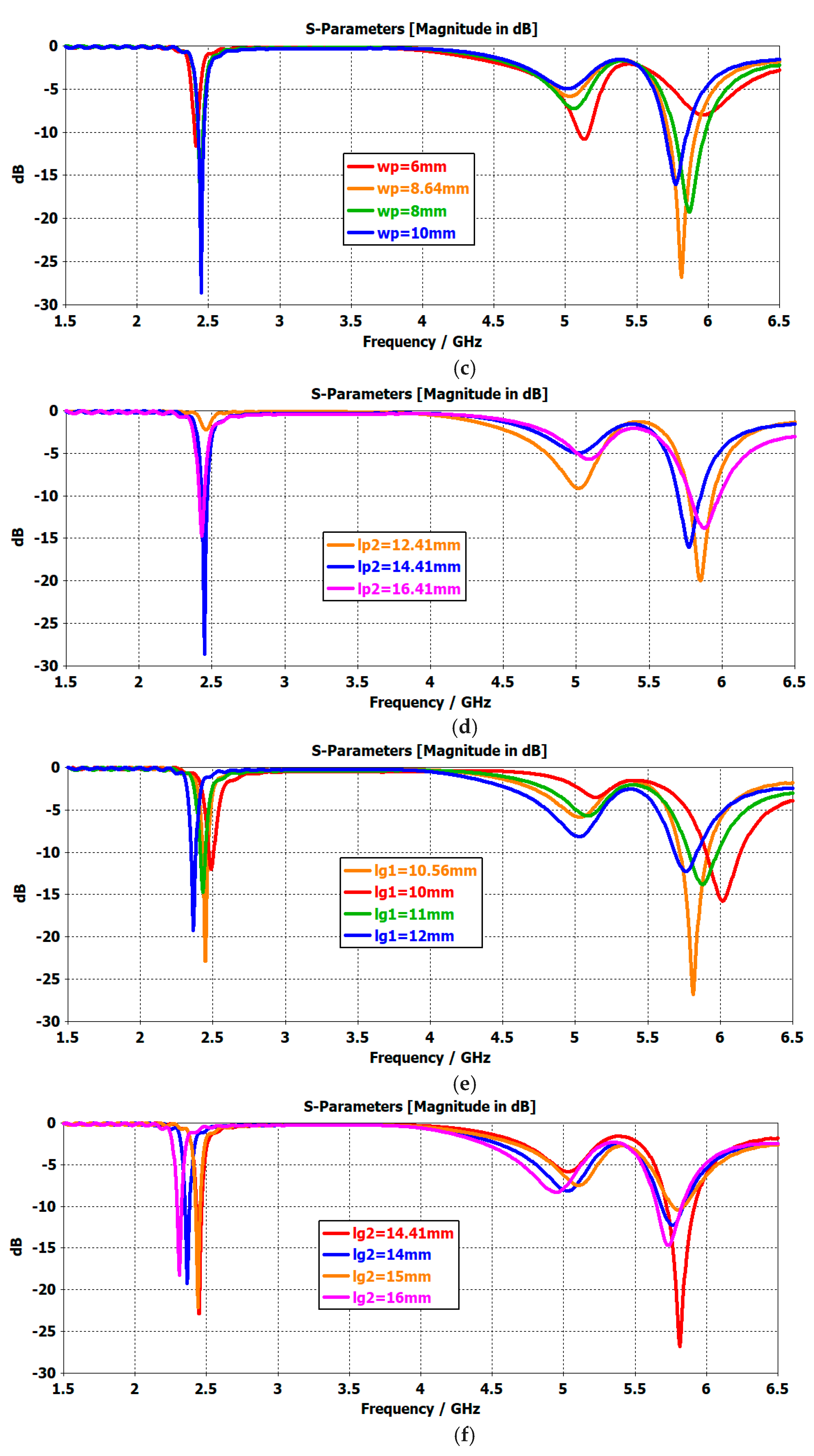
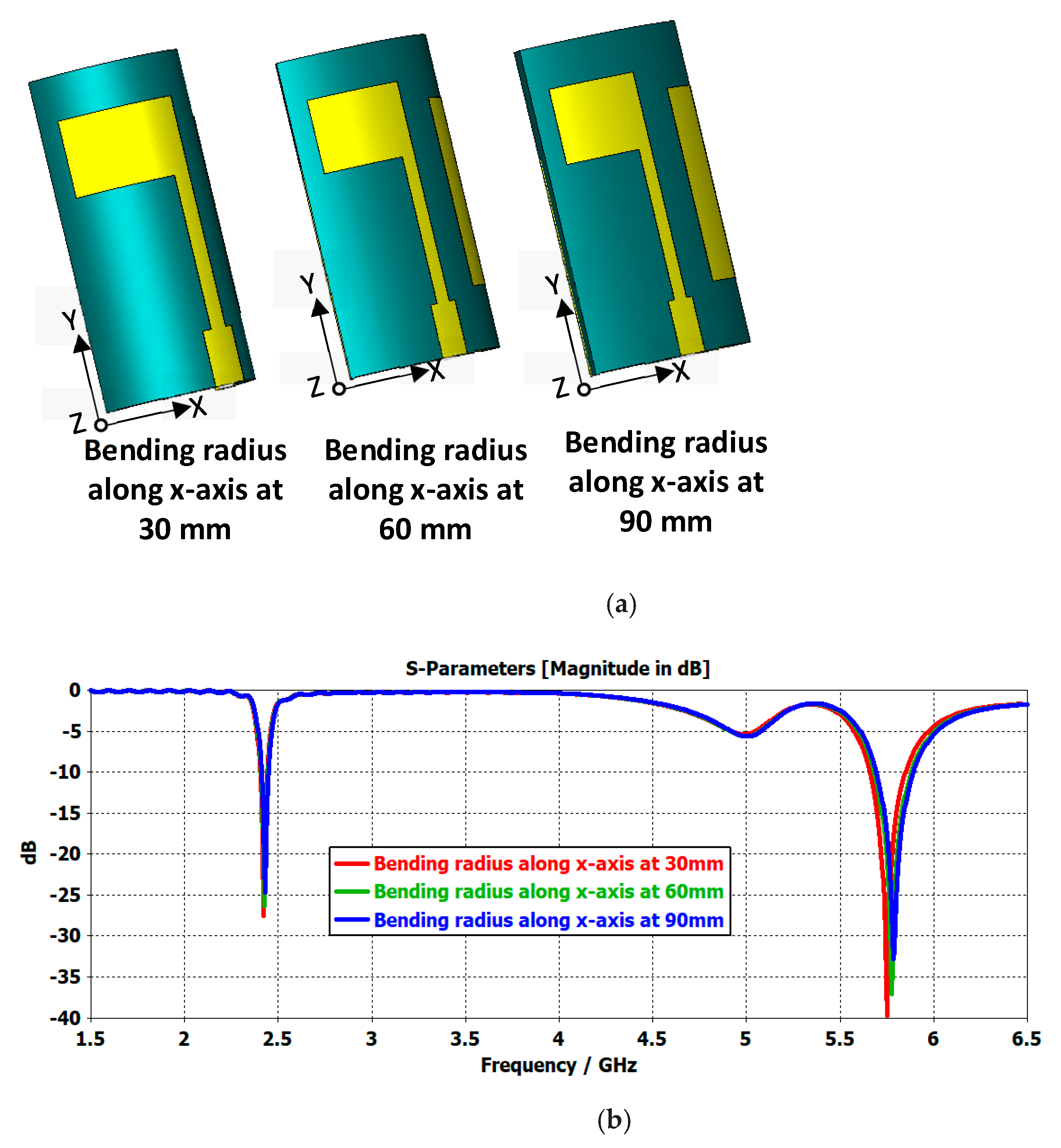
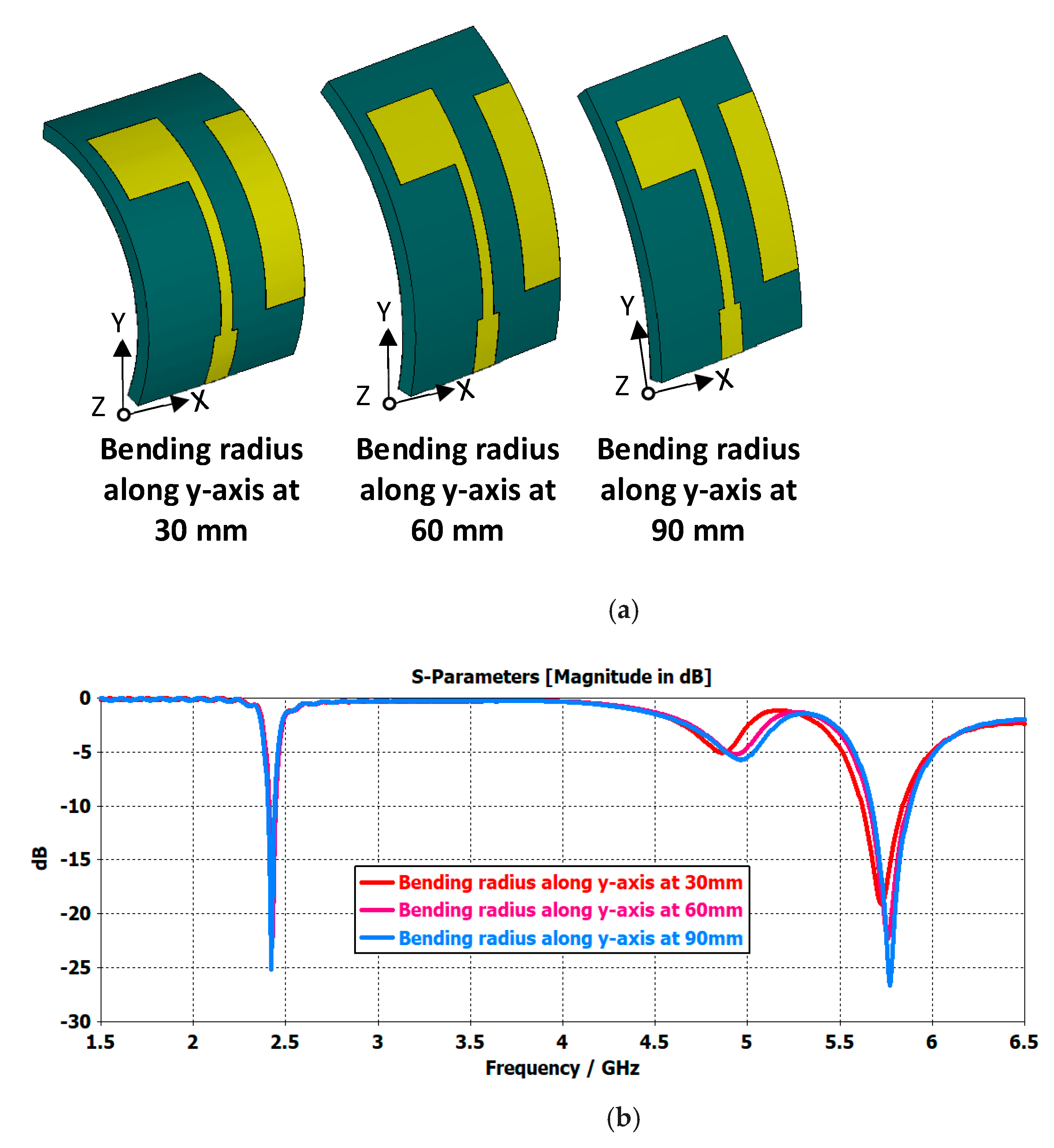
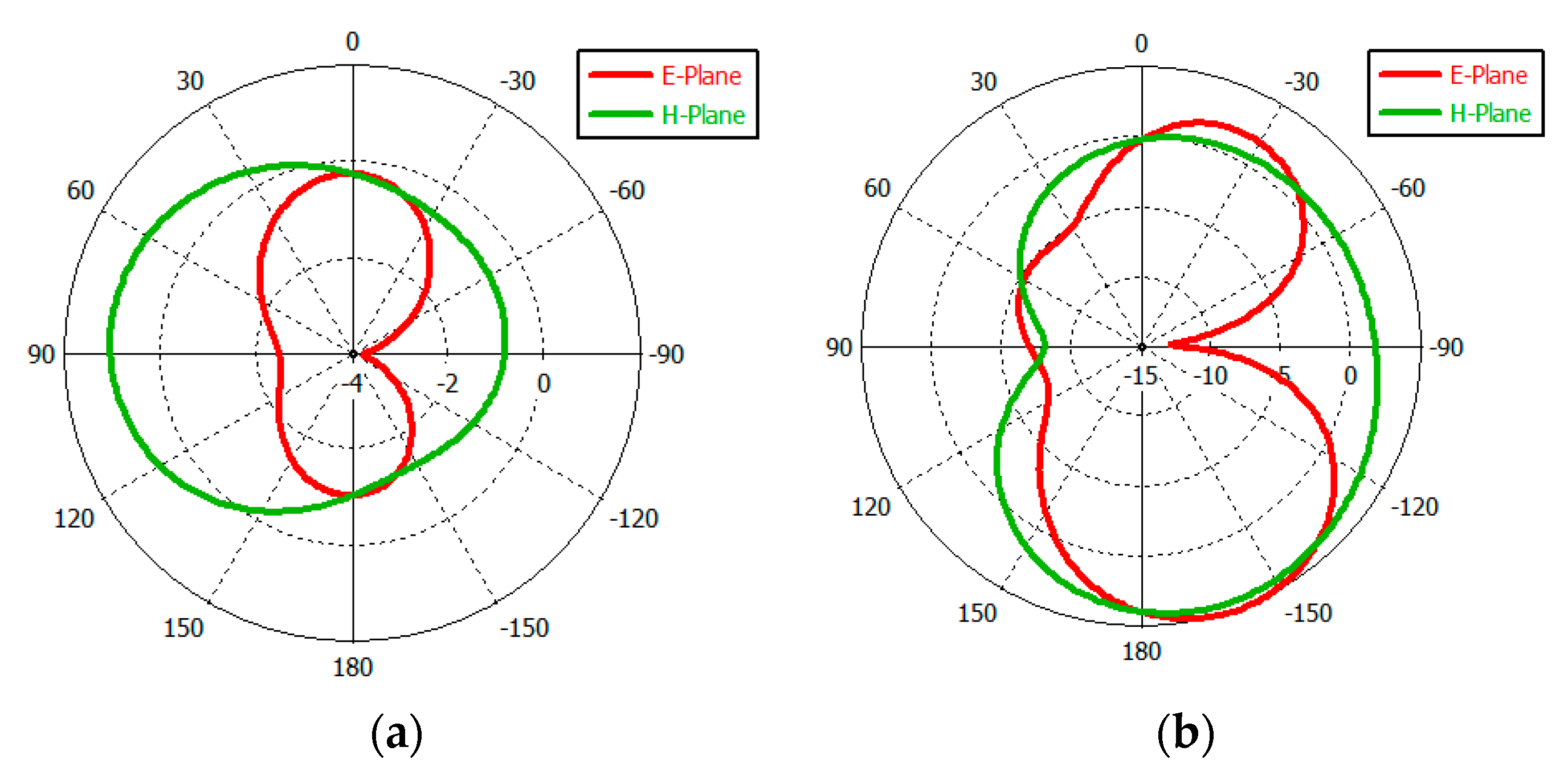
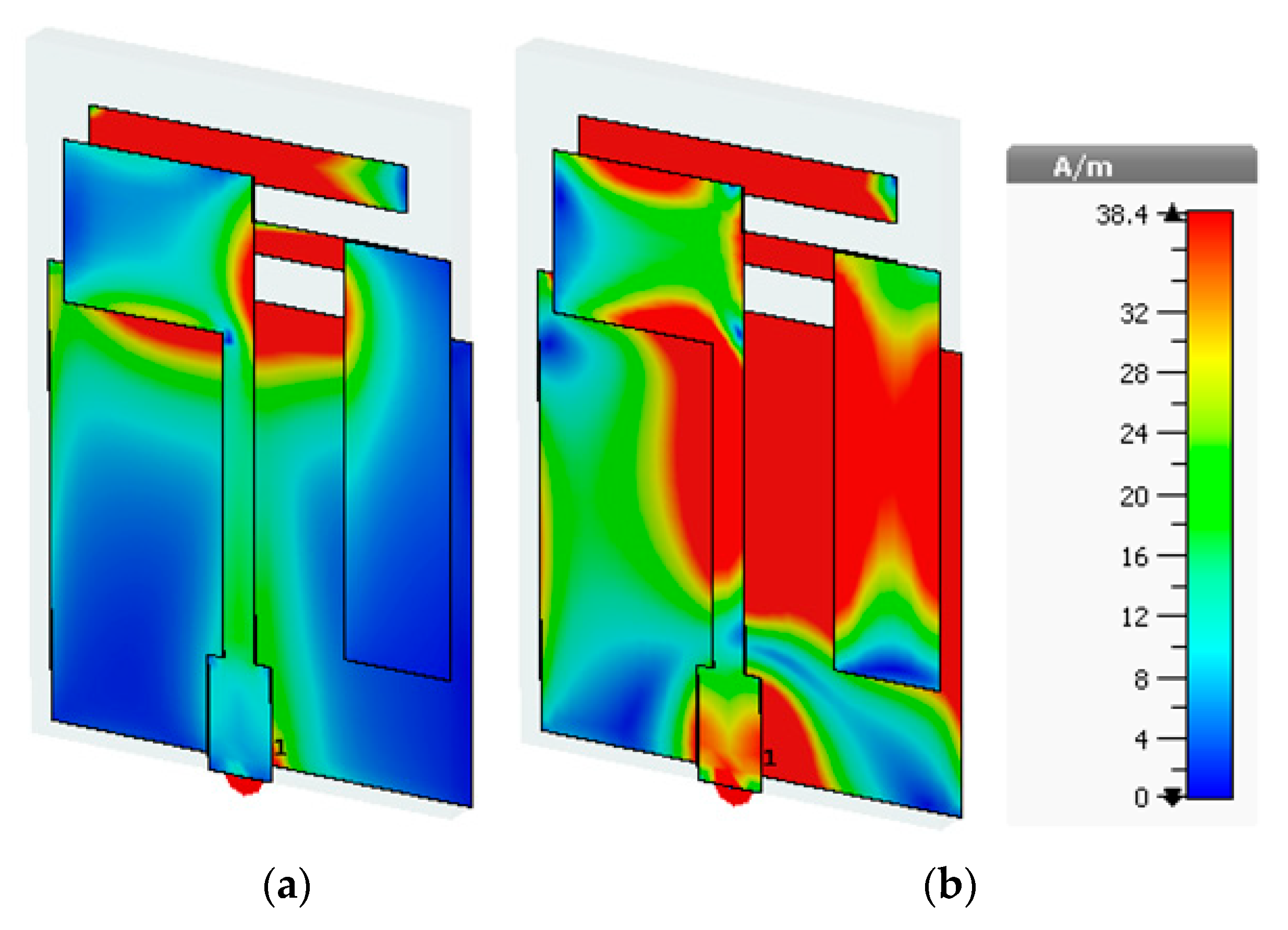


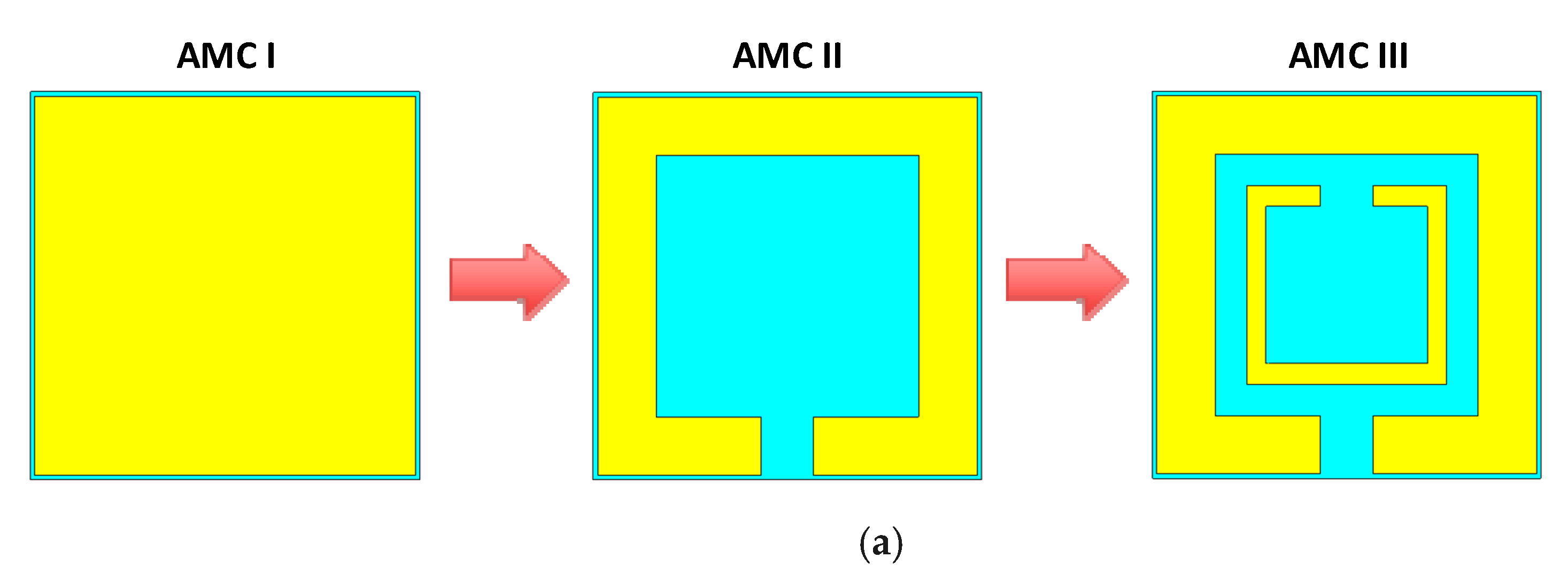

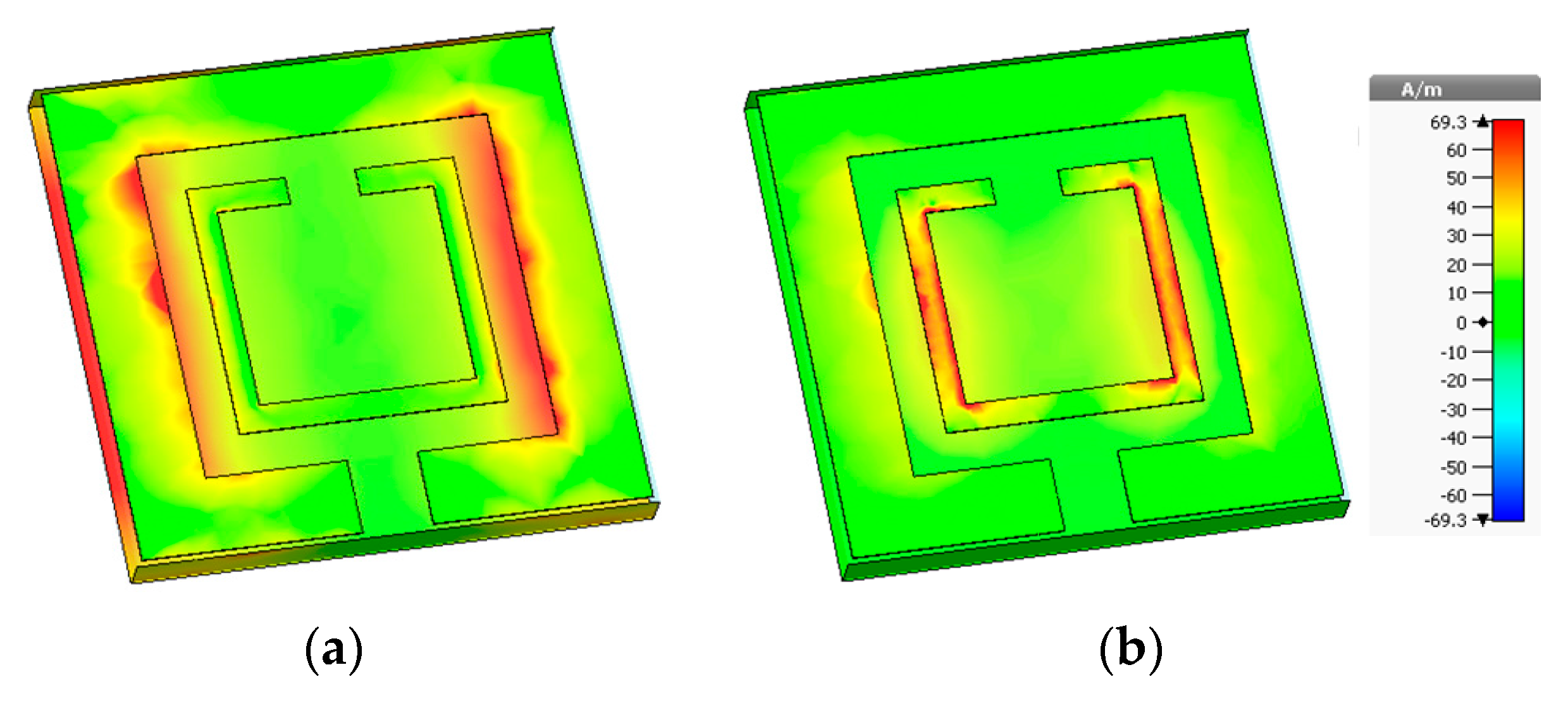


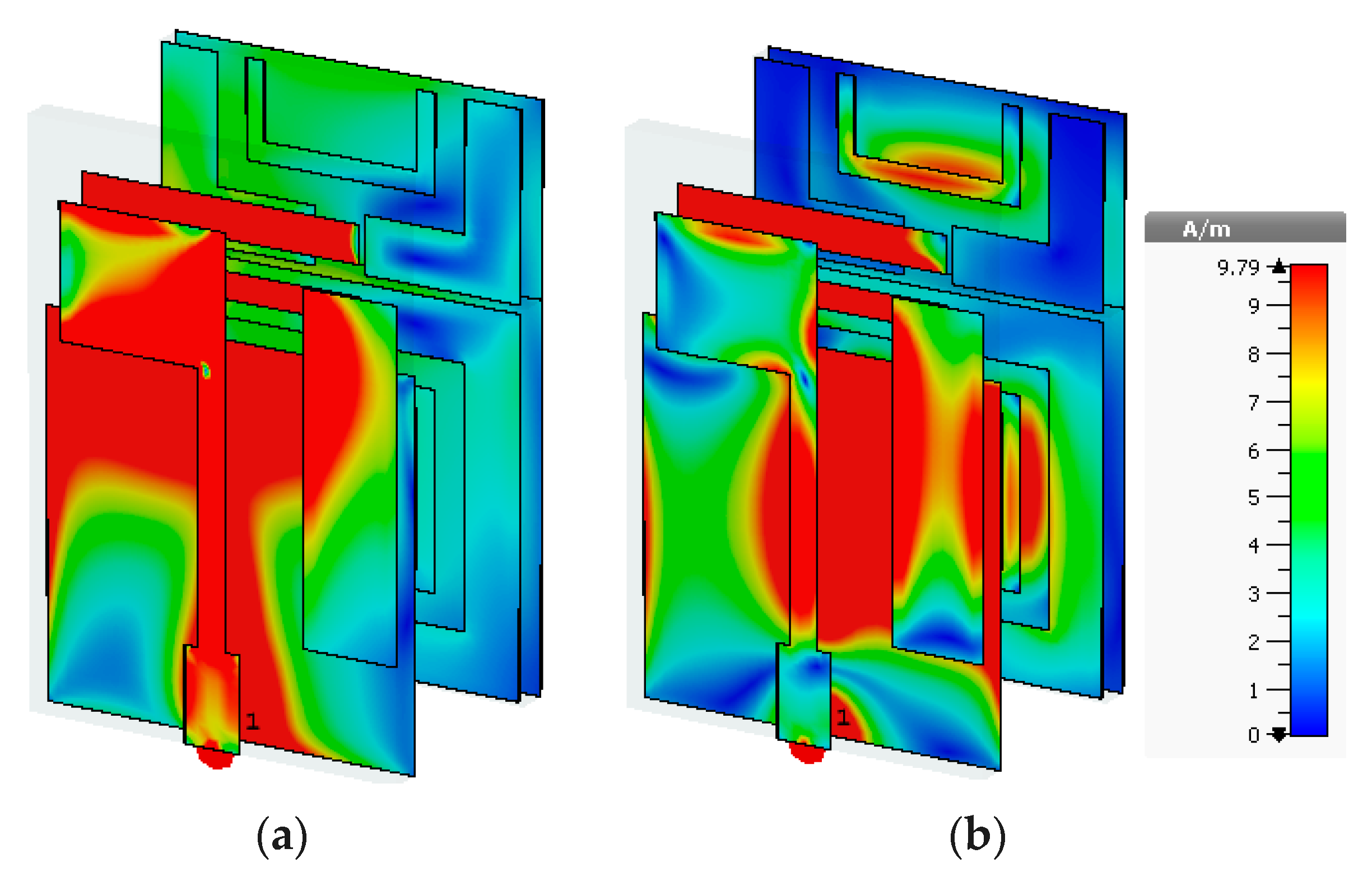
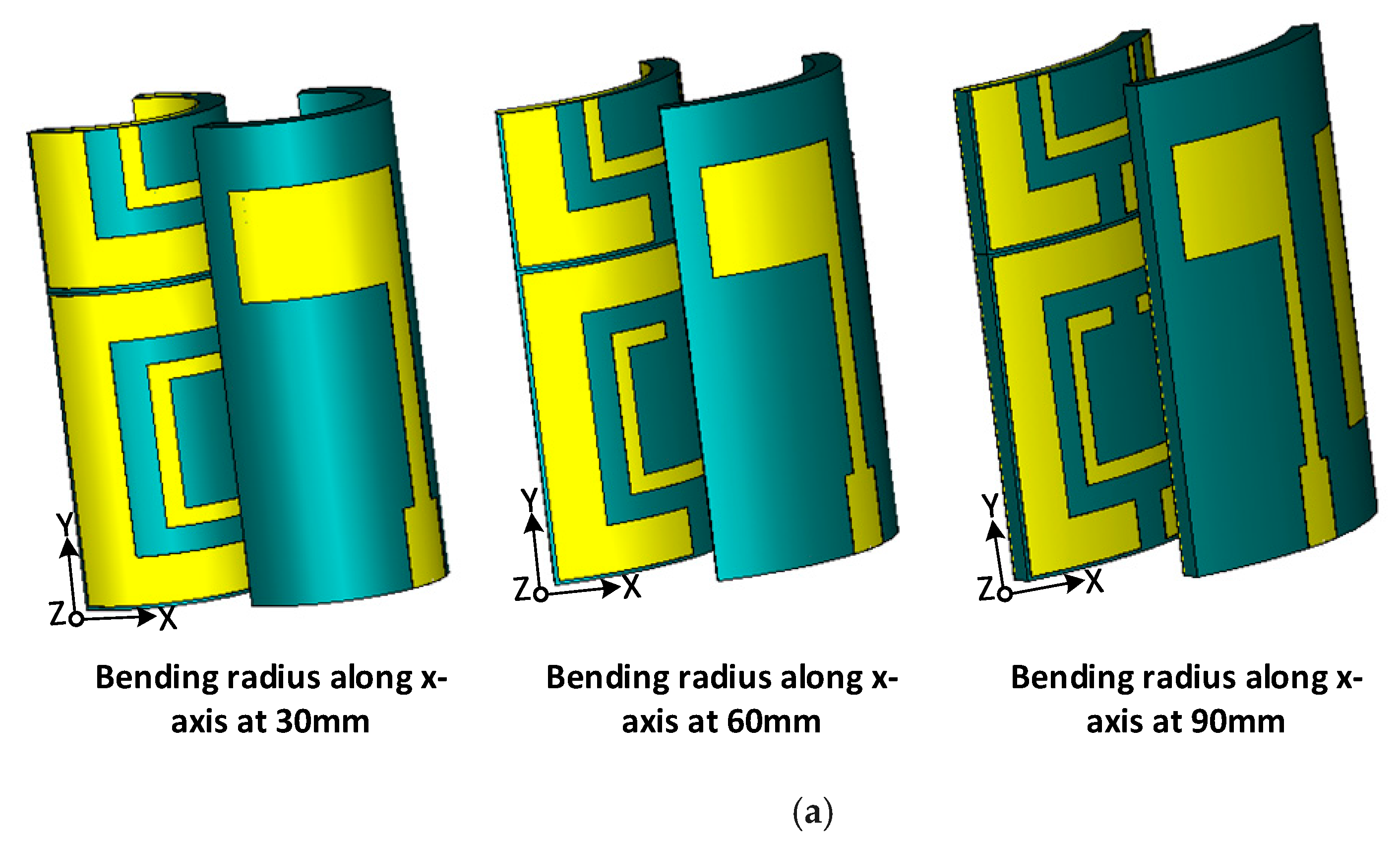
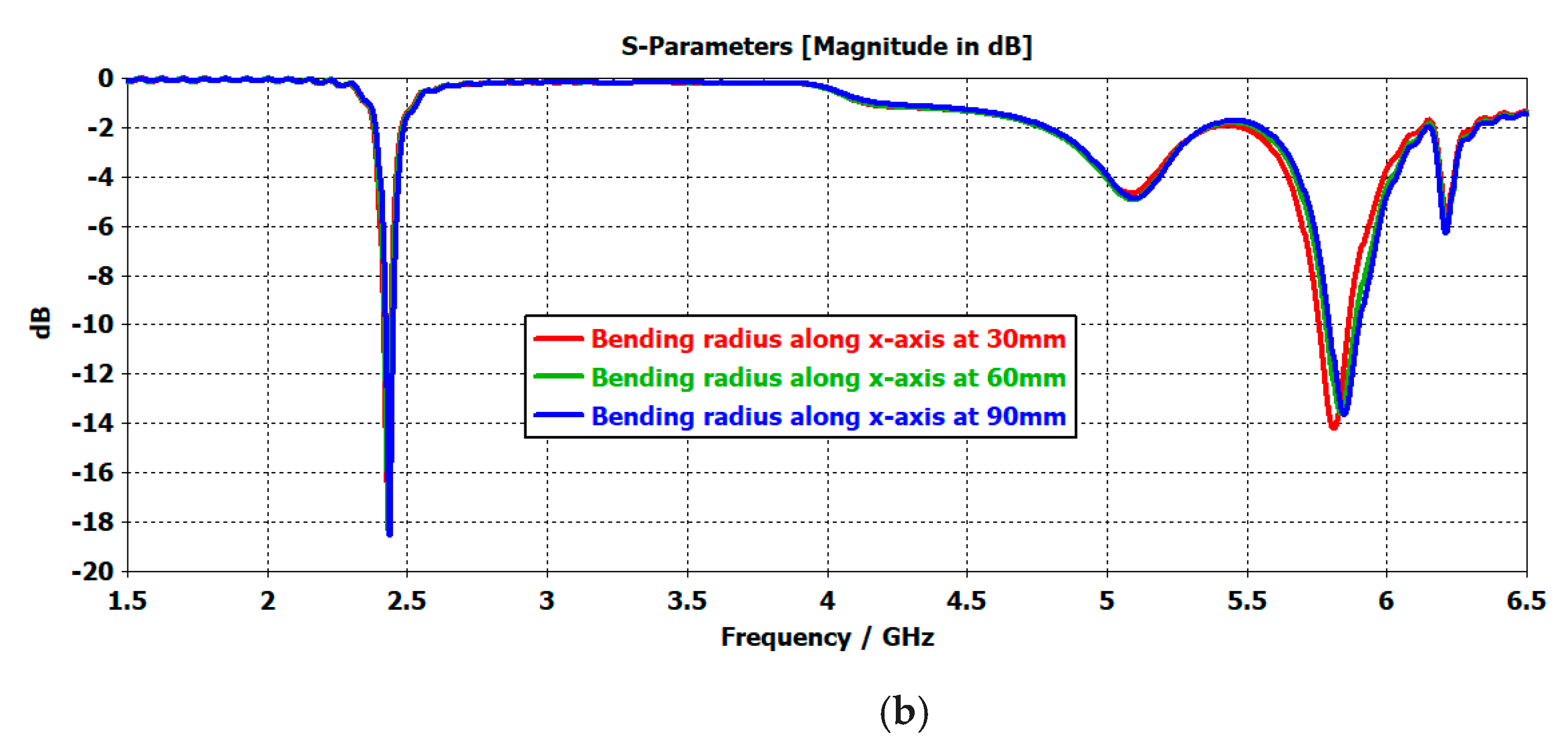
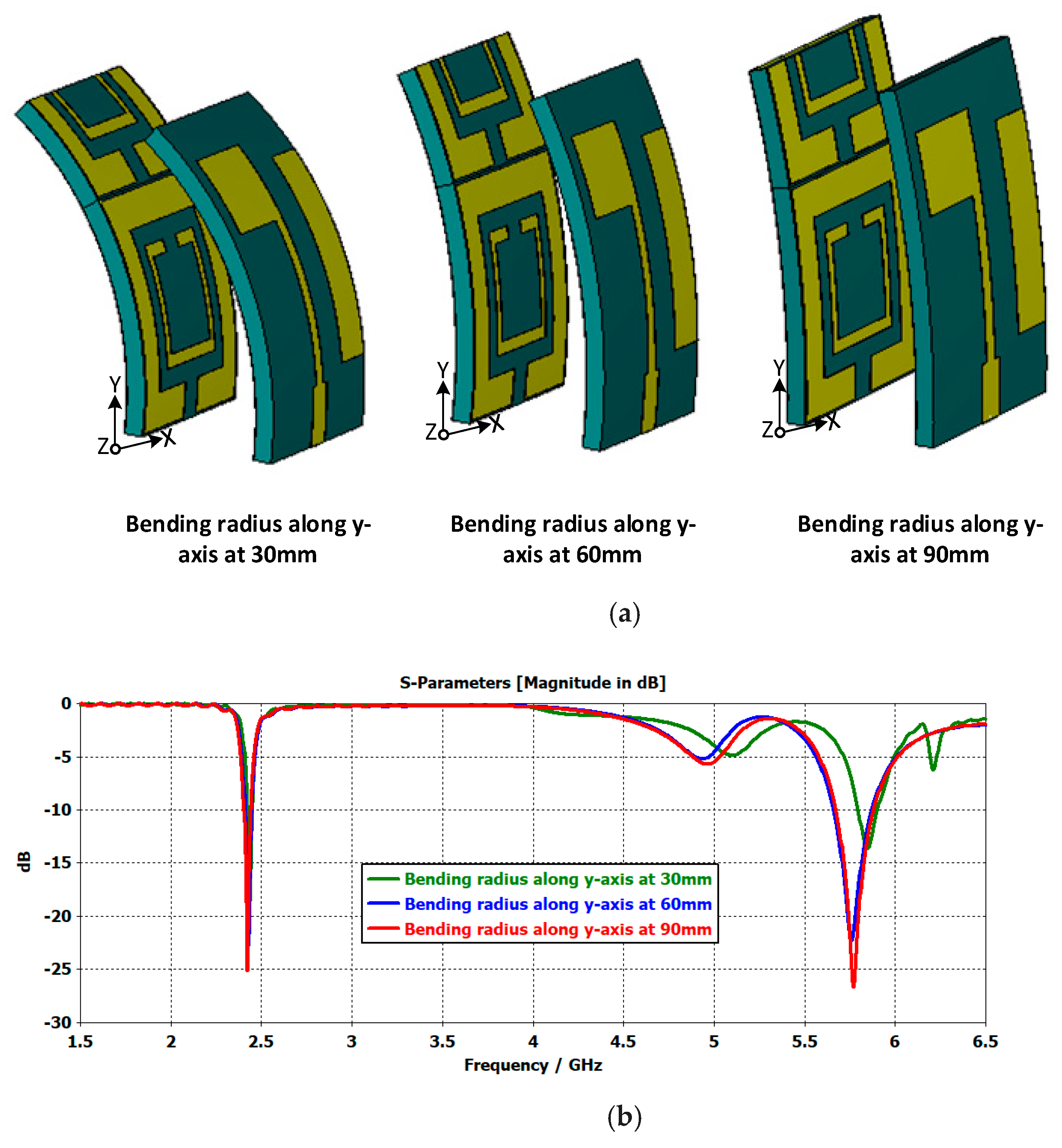

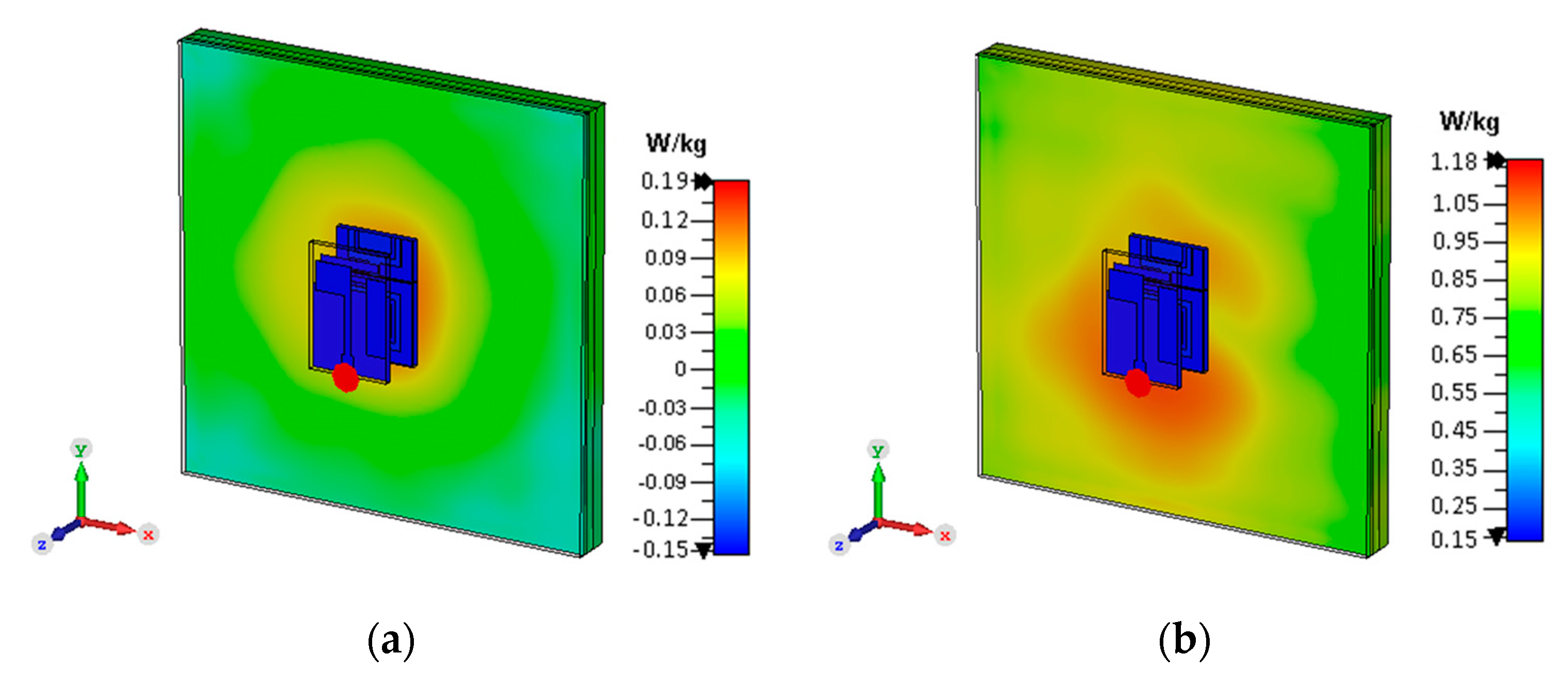




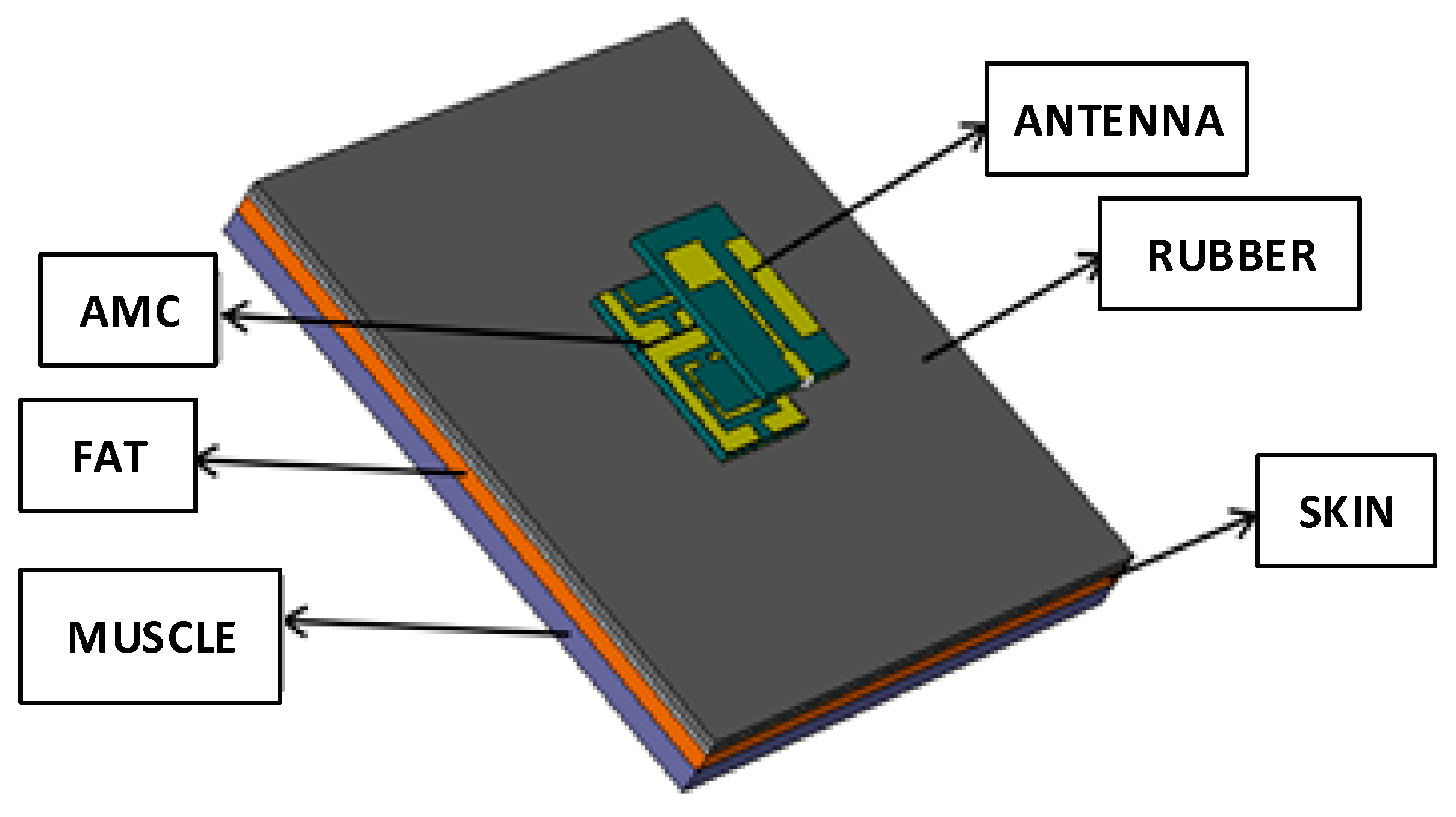


| Dimensions | Values (mm) | Dimensions | Values (mm) |
|---|---|---|---|
| Ws | 19.22 | Wg | 19.21 |
| Ls | 28.81 | Lg | 19.22 |
| Lf | 4.80 | wg1 | 1.92 |
| Wf | 2.88 | wg2 | 1.92 |
| wf1 | 1.44 | wg3 | 1.92 |
| Wp | 8.64 | lg1 | 10.56 |
| Lp | 20.17 | lg2 | 14.41 |
| wp1 | 7.20 | lg3 | 3.27 |
| lp1 | 13.45 | lg4 | 6.72 |
| Wps | 4.80 | lp2 | 6.72 |
| Lps | 17.29 | C | 1.34 |
| Inductors | Values | Capacitors | Values (pF) | Resistors | |
|---|---|---|---|---|---|
| L0 | 0.1 | C0 | 2.0 | R1 | 60 |
| L1 | 0.9 | C1 | 4.2 | R2 | 60 |
| L2 | 39 | C2 | 19 | Zs | 50 |
| Dimensions | Values (mm) | Dimensions | Values (mm) |
|---|---|---|---|
| Uw | 19.22 | Ul | 19.22 |
| Uw1 | 18.79 | Ul1 | 18.79 |
| Ul2 | 2.90 | Ul3 | 13 |
| Ul4 | 9.87 | Ul5 | 7.79 |
| Uw2 | 9.87 | Uw3 | 13 |
| Uw4 | 7.79 | Uw5 | 8.10 |
| Uw6 | 5.20 |
| Human Tissues | Relative Permittivity | Electrical Conductivity (S/m) | Thickness (mm) |
|---|---|---|---|
| Skin | 41.3 | 0.88 | 1 |
| Fat | 5.3 | 0.05 | 3 |
| Muscle | 54.8 | 0.96 | 4 |
| Ref. No. | Dimensions (mm3) | Operating Frequency (GHz) | Substrate Material | Realized Gain (dB) | Total Efficiency (%) | SAR (W/kg) @ 1 g |
|---|---|---|---|---|---|---|
| [8] | 40 × 124 × 1.2 | 0.7, 1.8 | Rubber | <3.8 | - | 0.18 and 1.26 |
| [9] | 40 × 38 × 0.5 | 2.47 | Metal | <3.76 | <95 | - |
| [10] | 33 × 41 × 1.2 | 1.5, 2.4 | Polycarbonate | 2.2 and 4.4 | 63, 83 | 0.021 |
| [11] | 42 × 32 × 1.6 | 0.63, 3.21, 3.63 | FR-4 | <3.69 | - | - |
| [12] | 31 × 30 × 1.6 | 2.4, 3.5 | FR-4 | <2.25 | - | - |
| [13] | 30 × 15 × 1.6 | 2.4 | FR-4 | <4 | - | - |
| [14] | 35 × 32 × 1.6 | 1.9, 2.3, 2.4, 2.6, 5.2, 5.8 | FR-4 | <6.6 | <82 | - |
| [15] | 35 × 30 × 0.5 | 1.7, 2.4, 3.5, 5.1 | FR-4 | <2.04 | 96, 94, 95, 54 | - |
| [16] | 40 × 40 × 0.4 | 1.57, 1.94, 2.4 | FR-4 | 0.5, 1.4, 2 | 53, 89, 90 | - |
| [17] | 30 × 30 × 1 | 2.4, 5.2 | FR-4 | - | - | - |
| [18] | 49 × 35 × 5 | 1.68, 1.8, 2.4 | FR-4 | <1.57 | <38 | - |
| [19] | 38 × 32 × 1.125 | 2.4, 5.2 | Display glass | - | 60, 65 | - |
| [20] | 32 × 32 × 0.4 | 2.4, 3.4, 4.9 | FR-4 | 68, 91, 74 | - | |
| [21] | (3.14 × 212 × 10 | 2.4 | Rogers4050 | 1.84 | <66 | 0.515 |
| [22] | 50 × 40 × 5 | 2.4 | FR-4 | 1 | <67 | - |
| [23] | 35 × 35 × 5 | 1.57, 2.4, 3.5 | FR-4 | 0.84, 1.54, 1.8 | 75, 86, 86 | - |
| [24] | 37.5 × 37.5 × 7.25 | 2.4 | FR-4 (4.3, 0.02) | <2.48 | <62 | 1.0569 |
| [25] | (3.14 × 232 × 10) | 2.4 | - | <2.6 | <65 | - |
| [26] | 45 × 25 × 1.5 | 0.8, 2.55, 3.5 | - | <4.7 | <88 | - |
| [27] | 40 × 40 × 1.52 | 0.9, 1.9, 2.5, 1.5, 2.4, 5 | Plastic | 0.42, 1.53, 1.79, 1.17, 3.16, 1.63 | <50 | - |
| [28] | 43.5 × 28.5 × 1.2 | 0.915 | Plastic | −0.77 | <46 | 0.004 |
| [This Work] | 28.81 × 19.22 × 1.58 | 2.45, 5.8 | Roger 3003C | 2.44, 6.17 | 50, 72 | 0.19 and 1.18 |
Publisher’s Note: MDPI stays neutral with regard to jurisdictional claims in published maps and institutional affiliations. |
© 2021 by the authors. Licensee MDPI, Basel, Switzerland. This article is an open access article distributed under the terms and conditions of the Creative Commons Attribution (CC BY) license (https://creativecommons.org/licenses/by/4.0/).
Share and Cite
Shahzad, M.A.; Paracha, K.N.; Naseer, S.; Ahmad, S.; Malik, M.; Farhan, M.; Ghaffar, A.; Hussien, M.; Sharif, A.B. An Artificial Magnetic Conductor-Backed Compact Wearable Antenna for Smart Watch IoT Applications. Electronics 2021, 10, 2908. https://doi.org/10.3390/electronics10232908
Shahzad MA, Paracha KN, Naseer S, Ahmad S, Malik M, Farhan M, Ghaffar A, Hussien M, Sharif AB. An Artificial Magnetic Conductor-Backed Compact Wearable Antenna for Smart Watch IoT Applications. Electronics. 2021; 10(23):2908. https://doi.org/10.3390/electronics10232908
Chicago/Turabian StyleShahzad, Muhammad Aamer, Kashif Nisar Paracha, Salman Naseer, Sarosh Ahmad, Muhammad Malik, Muhammad Farhan, Adnan Ghaffar, Mousa Hussien, and Abu Bakar Sharif. 2021. "An Artificial Magnetic Conductor-Backed Compact Wearable Antenna for Smart Watch IoT Applications" Electronics 10, no. 23: 2908. https://doi.org/10.3390/electronics10232908









